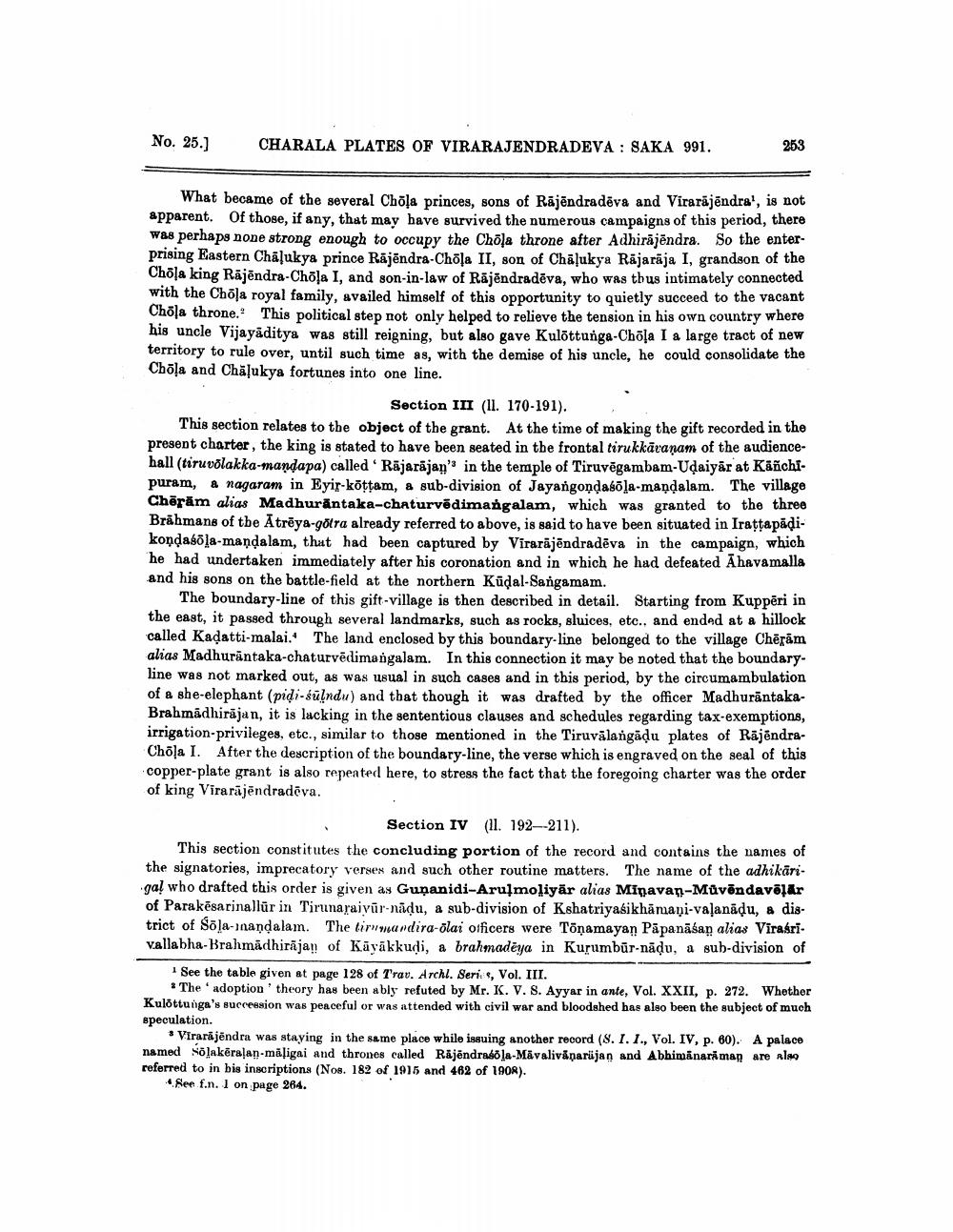________________
No. 25.)
CHARALA PLATES OF VIRARAJENDRADEVA : SAKA 991.
253
What became of the several Chola princes, sons of Rajendradēva and Virarājēndra', is not apparent. Of those, if any, that may have survived the numerous campaigns of this period, there Was perhaps none strong enough to occupy the Chõļa throne after Adhirājēndra. So the enterprising Eastern Chalukya prince Rajendra-Chola II, son of Chalukya Räjarāja I, grandson of the Chola king Rājēndra-Chöja I, and son-in-law of Rājēndradēva, who was thus intimately connected with the Chola royal family, availed himself of this opportunity to quietly succeed to the vacant Chõla throne. This political step not only helped to relieve the tension in his own country where his uncle Vijayaditya was still reigning, but also gave Kulottunga-Chola I a large tract of new territory to rule over, until such time as, with the demise of his uncle, he could consolidate the Chõļa and Chäļukya fortunes into one line.
Section III (11. 170-191). This section relates to the object of the grant. At the time of making the gift recorded in the present charter, the king is stated to have been seated in the frontal tirukkāranam of the audiencehall (tiruvolakka-mandapa) called Rājarājan' in the temple of Tiruvēgambam-Udaiyār at Käñchipuram, a nagaram in Eyir-köttam, a sub-division of Jayangondasola-mandalam. The village Chērām alias Madhurāntaka-chaturvēdimangalam, which was granted to the three Brāhmans of the Ātrēya-göra already referred to above, is said to have been situated in Irattapādikondasoļa-mandalam, that had been captured by Virarājēndradēva in the campaign, which he had undertaken immediately after his coronation and in which he had defeated Ahavamalla and his sons on the battle-field at the northern Kudal-Sangamam.
The boundary-line of this gift-village is then described in detail. Starting from Kupperi in the east, it passed through several landmarks, such as rocks, sluices, etc., and ended at a hillock called Kadatti-malai. The land enclosed by this boundary-line belonged to the village Chērām alias Madhurāntaka-chaturvēdimangalam. In this connection it may be noted that the boundary. line was not marked out, as was usual in such cases and in this period, by the circumambulation of a she-elephant (pidi-sūIndu) and that though it was drafted by the officer MadhurāntakaBrahmadhirājan, it is lacking in the sententious clauses and schedules regarding tax-exemptions, irrigation privileges, etc., similar to those mentioned in the Tiruvālangädu plates of RajendraChola I. After the description of the boundary-line, the verse which is engraved on the seal of this copper-plate grant is also repeated here, to stress the fact that the foregoing charter was the order of king Virarājēndradeva.
Section IV (11. 192--211). This section constitutes the concluding portion of the record and contains the names of the signatories, imprecatory verses and such other routine matters. The name of the adhikariga! who drafted this order is given ay Gunanidi-Aruļmoliyar alias Minavan-Mûvēndavājar of Parakēsarinallur in Tirunaraivūr-nadu, a sub-division of Kshatriyasikhamani-vaļanādu, a district of Sāļa-nandalam. The timmardira-olai officers were Tõnamayan Pāpanāśan alias Virasri. vallabha-Brahmädhirajan of Kāväkkudi, a brahmadēya in Kurumbūr-nadu, a sub-division of
See the table given at page 128 of Trav. Archl. Seris, Vol. III.
* The adoption theory has been ably refuted by Mr. K. V. 8. Ayyar in ante, Vol. XXII, p. 272. Whether Kulottunga's succession was peaceful or was attended with civil war and bloodshed has also been the subject of much speculation.
* Virarājēndra was staying in the same place while issuing another record (8. 1. I., Vol. IV, p. 60). A palace named Nolakēralan-maligai and thrones called Rājēndrasola-Mavalivånarijan and Abhimanarå man are plac referred to in bis inscriptions (Nos. 182 of 1915 and 462 of 190R).
Ree f.n. I on page 264.




